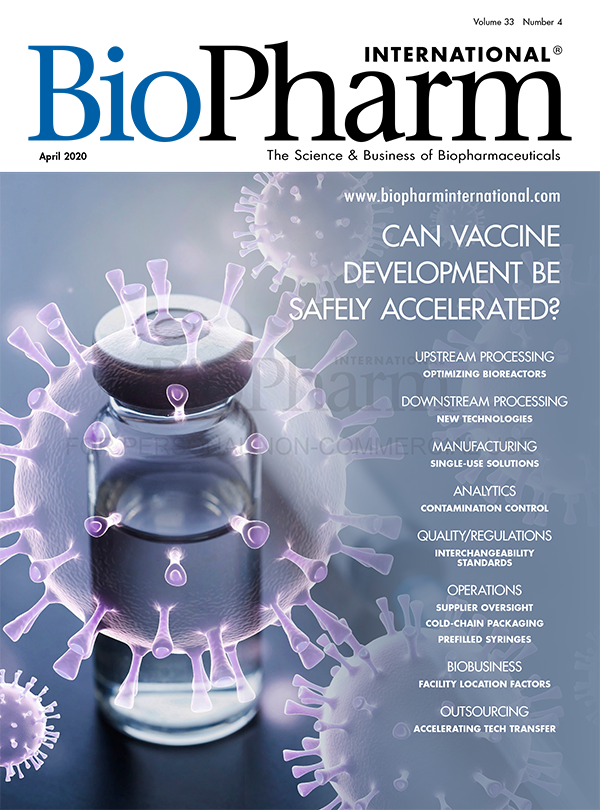
Lower Taxes, More Flexibility Crucial to Retaining Pharma Employment
Reprinted by permission from BioPharm International, April 2020 | Volume 33, Issue 4, pages 52-53.

As politicians focus on drug cost reduction, biopharmaceutical companies in the US are moving to states with lower taxes and relocating some facilities that had been offshore.
Public pressure to reduce drug costs has led to a number of proposals to reduce drug prices. Among the alternatives discussed so far have been de facto price controls and syncing prices with those in other global markets. In December 2019, the United States Department of Health and Human Services introduced a Safe Importation Action Plan outlining two pathways for allowing the safe reimportation of lower cost drugs from Canada.
Although these proposals have not yet become law, biopharmaceutical company executives are reacting to regulatory uncertainty by focusing more intensely on reducing operating costs, according to John Boyd, CEO of the Boyd Company, a site selection advisory company. “Operating costs have always been important for life-sciences site selection, but they’ve never been as important as they are now, as the industry focuses on price reduction. Many of our pharma clients see site selection as a preferred market-based way to reduce operating costs,” he told BioPharm International.
Operating costs vary highly among major life-sciences sites, and labor costs make up roughly 60% of those costs, says Boyd. In the US, Austin, TX, and Raleigh, NC, are currently among the fastest growing metropolitan areas, and both are attracting biopharma investment. So far, the Raleigh-Durham area in North Carolina offers the lowest operating costs of any US location, Boyd says, and boasts the presence of some leading universities such as Duke, University of North Carolina, and North Carolina State. Eli Lilly recently selected Raleigh as the location for a new $474-million, 462-employee facility to manufacture injectable and other diabetes therapies. The Austin area, meanwhile, is seeing increased investment in biopharma, due to life-sciences developments such as the University of Texas’ Dell Medical Campus and facilities affiliated with nearby Texas A&M.

Bill Bullock, the senior vice president for economic development and statewide operations at the North Carolina Biotechnology Center in Durham, NC, referred to the life-sciences hub as a “good investment” for the state.
“Agriculture was, and remains, the state’s largest revenue producer. So that became a natural sector to absorb gene-based and other new technologies,” he says. “Concurrently, the state tweaked its educational infrastructure to prepare a workforce to handle tableting and fill-finish where textiles and furniture once reigned. Thus, the foundation for a biomanufacturing bonanza that has even evolved into global leadership in gene and cell therapy manufacturing.”
North Carolina also offers incentives for companies looking to house their sites in the life-sciences hub, according to Bullock. They include a job development investment grant, the One North Carolina Fund, both discretionary performance-based programs to respond to job creation projects, and public infrastructure and transportation programs.
“Incentives provided by local units of government are key components of a broad incentives package that can help companies expand or relocate. Most are based on investment, anticipated taxes, and/or the number of jobs to be created,” Bullock says. “North Carolina offers life-science companies an educated workforce, access to hundreds of life-science companies and service providers, a well-established supply chain, and a creative and competitive landscape to support location costs and facility expansion. It’s the best value in biomanufacturing.”
Boyd’s latest analysis compared major operating costs in 2019 for a representative 300,000-ft2 biomanufacturing facility employing 300 hourly staffers. Examining costs for 25 US, European, and Asian locations, research found that they ranged from $58.7 million in Copenhagen to $13.7 million in Bangalore. In the US, costs ranged from $55.4 million in New York to $37.2 million in Raleigh/Durham, NC.
“In the US, there has already been a mass exodus of human capital to states that have right-to-work laws,” says Boyd. These laws establish “at will” employment and make membership in labor unions voluntary, reducing union power as well as labor costs for employers. There has also been a trend to “reshore” some operations and bring them back to the US in lower-cost labor states, he says. “For areas such as Bangalore in India, the initial numbers may be compelling, but investors have found additional hidden costs,” he says, including training, and, in the US, boosting corporate participation in federal procurement programs has become a political issue that has both Republican and Democratic party support, he says. Boyd notes that new life-science regional hubs may be on the horizon, depending on how new regulations take shape in the US. Amgen, for example, is building a new 1600-employee facility in Greenwich, RI. Other potential areas for future development could include Southern Florida, Phoenix, AZ, Las Vegas, NV, and the Winston-Salem area of North Carolina near Wake Forest University.
Holding the line on more state taxes
In the meantime, many municipalities are getting the message loud and clear, to hold the line on new corporate taxes, says Boyd. New Jersey, which is the nation’s largest biopharmaceutical and pharmaceutical development and manufacturing center, may offer a cautionary tale.
The state recently increased corporate and personal income taxes, on top of high property taxes, making it more difficult for companies located in the state to remain competitive and reducing disposable income for working professionals, says Boyd. Over the past 15 years, he noted in a December 2019 interview, higher taxes in the state have resulted in $30 billion in personal income moving to lower cost, more corporate friendly locations. New Jersey officials have also proposed a millionaire’s tax that would impose 10.75% in income tax on individuals earning $1 million per year or more. The proposed regulations could affect 20,000 state residents, many of them business owners, and could decrease investment in the state. New York, California, and Massachusetts already have similar laws in place.
As for North Carolina, the state’s 2.5% corporate income tax is the lowest rate of states that levy this tax, according to Bullock. It also boasted the seventh lowest commercial and ninth lowest industrial effective property tax rates in the country in 2017.
“The state offers a number of sales and use tax exemptions,” Bullock says. “For example, in 2018 North Carolina significantly increased long-term business cost savings through single sales factor apportionment for multistate corporations. There are also exemptions for manufacturing machinery and related equipment, as well as raw materials, fuel, piped natural gas, and electricity used for manufacturing. Other exemptions and credits are available for R&D and software publishing, pollution abatement equipment, recycling, and historic preservation.”
